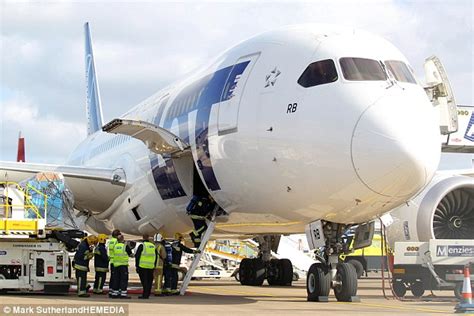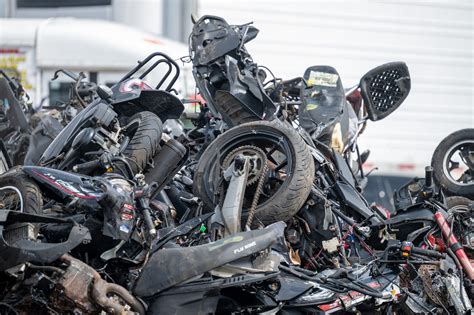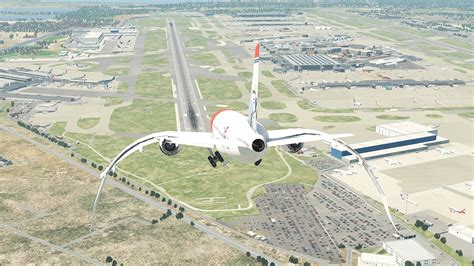
A series of four emergency landings involving Boeing 787 Dreamliner aircraft within a single month has ignited fresh concerns about the safety and reliability of the wide-body jet, particularly in light of recent whistleblower allegations regarding Boeing’s manufacturing processes. The incidents, occurring on separate flights operated by different airlines, have prompted increased scrutiny from aviation regulators and renewed anxieties among passengers and industry experts.
The recent incidents, while varied in nature, collectively paint a concerning picture. They include a United Airlines 787-9 Dreamliner flight from Houston to Frankfurt that was forced to return shortly after takeoff due to a possible oil leak in one of its engines. Then, an All Nippon Airways (ANA) 787-8 Dreamliner flying domestically in Japan made an emergency landing because of a crack in a cockpit window. Further adding to the list, a LATAM Airlines 787-9, en route from Auckland to Santiago, experienced a technical issue that caused a sudden mid-air dive, injuring multiple passengers. Finally, a TUI Airways 787-9 Dreamliner flying from Montego Bay to Gatwick was forced to divert to Bermuda due to a medical emergency onboard.
These incidents have amplified the impact of whistleblower claims made by former Boeing employee, Sam Salehpour, who testified before Congress, alleging that Boeing skirted safety protocols during the assembly of the 787 Dreamliner, potentially leading to premature structural failure. Salehpour claims that gaps larger than specified were present in the joints of the fuselage, and that Boeing used improper force to close these gaps instead of addressing the underlying manufacturing issues. He alleges that these actions could compromise the structural integrity of the aircraft over time, potentially leading to catastrophic failures. “I did see them taking shortcuts,” Salehpour stated, adding that he faced retaliation for raising his concerns internally.
The Federal Aviation Administration (FAA) is currently investigating Salehpour’s claims, which Boeing vehemently denies. The company has stated that it is confident in the long-term safety and durability of the 787 Dreamliner, citing extensive testing and analysis. “These claims about the integrity of the 787 are inaccurate,” Boeing said in a statement. “The FAA is reviewing these claims, and we will continue to cooperate with them.” However, the confluence of these emergency landings and the whistleblower’s allegations has created a perfect storm of public concern and regulatory pressure.
Details of the Emergency Landings:
The incidents themselves vary in severity and apparent cause, highlighting the complexity of aircraft safety and maintenance.
-
United Airlines Flight (Houston to Frankfurt): On [Date], a United Airlines Boeing 787-9 Dreamliner operating flight UA-XXX from Houston (IAH) to Frankfurt (FRA) was compelled to return to Houston shortly after takeoff. The reason cited was a suspected oil leak originating from one of the aircraft’s engines. While the airline described the incident as a “precautionary measure,” the unscheduled return disrupted travel plans for hundreds of passengers and raised concerns about potential engine issues. The specific engine model involved was not immediately disclosed. According to United Airlines, the aircraft landed safely, and passengers were rebooked on alternative flights. “The safety of our passengers and crew is always our top priority,” the airline stated.
-
All Nippon Airways (ANA) Domestic Flight: An All Nippon Airways (ANA) Boeing 787-8 Dreamliner, operating a domestic flight within Japan on [Date], was forced to make an emergency landing due to a crack that appeared in the cockpit window. Details surrounding the flight number and origin/destination remain unspecified. The incident is under investigation to determine the cause of the crack and assess potential structural implications. Though a cracked window may not seem dire, it can cause explosive decompression at higher altitudes.
-
LATAM Airlines Flight (Auckland to Santiago): The most serious of the recent incidents involved a LATAM Airlines Boeing 787-9 Dreamliner, flight LA-XXX, flying from Auckland (AKL) to Santiago (SCL) on [Date]. The aircraft experienced a technical issue that resulted in a sudden and significant mid-air dive. Initial reports suggest a possible malfunction in the aircraft’s flight control system, although the precise cause is still under investigation. The abrupt movement caused injuries to numerous passengers, with some requiring medical attention upon arrival in Santiago. LATAM issued a statement expressing regret for the incident and promising full cooperation with the investigation. “LATAM regrets the inconvenience and injury this situation may have caused its passengers, and reiterates its commitment to safety as its top priority,” the statement read. Some passengers have indicated the pilot lost control of the plane momentarily.
-
TUI Airways Flight (Montego Bay to Gatwick): On [Date], a TUI Airways Boeing 787-9 Dreamliner, flight BY-XXX, en route from Montego Bay (MBJ) to Gatwick (LGW), was diverted to Bermuda (BDA) due to a medical emergency involving a passenger onboard. While not directly related to aircraft malfunction, the diversion added to the string of incidents involving the 787 Dreamliner, further amplifying public awareness and concern. The passenger received medical attention in Bermuda, and the flight continued to Gatwick after a delay.
Whistleblower Allegations and Boeing’s Response:
The emergency landings have occurred against the backdrop of serious allegations leveled by Sam Salehpour, a former Boeing employee who worked as a quality engineer. Salehpour claims that he witnessed Boeing employees taking shortcuts during the assembly of the 787 Dreamliner, specifically regarding the joining of fuselage sections.
According to Salehpour, gaps larger than specified were present in the joints, and instead of properly addressing the underlying manufacturing issues, Boeing employees used excessive force to close these gaps. He alleges that this improper process could weaken the aircraft’s structure over time, making it more susceptible to premature failure. These alleged deviations from approved manufacturing procedures, Salehpour argues, could compromise the long-term safety of the 787 Dreamliner fleet.
In his testimony before Congress, Salehpour stated that he raised his concerns internally within Boeing but faced retaliation for doing so. He claims he was transferred to a different department and subjected to a hostile work environment. This aspect of the whistleblower’s allegations raises concerns about Boeing’s internal safety culture and the willingness of employees to report potential problems without fear of reprisal.
Boeing has vehemently denied Salehpour’s claims, asserting that they are inaccurate and do not reflect the company’s commitment to safety. The company maintains that the 787 Dreamliner is a safe and reliable aircraft, citing extensive testing and analysis to support its position. Boeing has also stated that it is cooperating fully with the FAA’s investigation into Salehpour’s allegations.
“We have full confidence in the 787 Dreamliner,” Boeing said in a statement. “These claims are inaccurate and do not represent the quality of work that Boeing employees perform every day. Safety is our top priority, and we are committed to ensuring the safety of our products and services.” Boeing further asserts that the manufacturing processes for the 787 Dreamliner are rigorously controlled and monitored, and that any deviations from approved procedures are promptly addressed.
FAA Investigation and Regulatory Oversight:
The FAA is currently investigating Salehpour’s allegations and is conducting a thorough review of Boeing’s manufacturing processes for the 787 Dreamliner. The investigation will focus on determining whether Boeing adhered to all applicable safety regulations and whether any deviations from approved procedures occurred.
The FAA’s investigation is crucial in ensuring the safety and airworthiness of the 787 Dreamliner fleet. If the FAA finds evidence to support Salehpour’s claims, it could take a number of actions, including requiring Boeing to implement corrective measures, issuing airworthiness directives, or even grounding the 787 Dreamliner fleet.
The FAA has stated that it is taking the whistleblower’s allegations seriously and is committed to conducting a thorough and impartial investigation. “The FAA is aware of the allegations and is investigating them,” the agency said in a statement. “We take all allegations seriously and will take appropriate action based on the findings of our investigation.” The investigation will include a review of Boeing’s manufacturing records, inspections of 787 Dreamliner aircraft, and interviews with Boeing employees.
Historical Context and Previous 787 Issues:
The Boeing 787 Dreamliner has faced its share of challenges since its introduction in 2011. One of the most significant issues involved the aircraft’s lithium-ion batteries, which experienced several incidents of overheating and fire in 2013. These incidents led to a temporary grounding of the entire 787 Dreamliner fleet while Boeing developed and implemented a fix.
The battery issues highlighted the importance of rigorous testing and quality control in ensuring the safety of new aircraft technologies. Boeing implemented several changes to the battery design and manufacturing process to address the problem, and the 787 Dreamliner fleet was eventually cleared to return to service.
In addition to the battery issues, the 787 Dreamliner has also experienced some other technical problems, including issues with its engines and electrical systems. However, Boeing has generally been able to address these problems through software updates, hardware modifications, and enhanced maintenance procedures.
Impact on Passengers and Airlines:
The recent emergency landings and whistleblower allegations have raised concerns among passengers and airlines about the safety and reliability of the 787 Dreamliner. Some passengers have expressed anxiety about flying on the aircraft, while airlines are closely monitoring the situation and working with Boeing and the FAA to ensure the safety of their operations.
The incidents could potentially lead to a decline in passenger confidence in the 787 Dreamliner, which could negatively impact airlines that operate the aircraft. Airlines may also face increased costs associated with enhanced maintenance and inspections.
The long-term impact of these events on the 787 Dreamliner’s reputation and sales remains to be seen. However, Boeing will need to take swift and decisive action to address the concerns and restore confidence in the aircraft.
Industry Expert Perspectives:
Aviation industry experts have offered a range of perspectives on the recent events. Some experts believe that the incidents are isolated and do not indicate a systemic problem with the 787 Dreamliner. They argue that the aircraft has a strong safety record overall and that the emergency landings were handled safely and effectively.
Other experts are more concerned, arguing that the incidents, combined with the whistleblower allegations, raise serious questions about Boeing’s quality control and manufacturing processes. They believe that a thorough investigation is needed to determine the root cause of the problems and to ensure that Boeing is taking adequate steps to address them.
“These incidents are certainly concerning, and they warrant a close look,” said [Name], an aviation safety consultant. “It’s important to determine whether there are any underlying issues that need to be addressed to prevent future incidents.”
Financial Implications for Boeing:
The safety concerns surrounding the 787 Dreamliner could have significant financial implications for Boeing. A decline in passenger confidence could lead to reduced demand for the aircraft, potentially impacting future sales. Moreover, any regulatory actions, such as airworthiness directives or fleet groundings, could result in substantial costs for Boeing and its airline customers. The cost of investigations, repairs, and potential design modifications could also strain Boeing’s financial resources.
The negative publicity surrounding the Dreamliner could also damage Boeing’s reputation and brand image, potentially affecting its overall market value. Investors are likely to closely monitor the situation and react to any developments that could impact Boeing’s financial performance. A prolonged period of uncertainty could lead to a decline in Boeing’s stock price and credit rating.
Boeing’s ability to effectively address the safety concerns and restore confidence in the 787 Dreamliner will be crucial in mitigating the potential financial impact. The company will need to demonstrate a commitment to quality and transparency to regain the trust of passengers, airlines, and investors.
Comparison to Airbus A350:
The Boeing 787 Dreamliner’s primary competitor is the Airbus A350. While both aircraft are wide-body, long-range jets, they differ in their design, manufacturing, and performance characteristics. The Airbus A350 has not faced the same level of scrutiny or experienced as many high-profile safety incidents as the 787 Dreamliner.
Some industry observers believe that the A350 has a more robust design and manufacturing process than the 787 Dreamliner. However, it’s important to note that the A350 is a newer aircraft, and its long-term safety record is still being established. Both aircraft are subject to rigorous regulatory oversight and are designed to meet the highest safety standards.
The recent concerns surrounding the 787 Dreamliner could potentially benefit Airbus by increasing demand for the A350. Airlines may consider switching to the A350 if they lose confidence in the 787 Dreamliner. However, Boeing remains a major player in the wide-body aircraft market, and its ability to address the safety concerns and restore confidence in the 787 Dreamliner will be crucial in maintaining its competitive position.
Future Outlook:
The future of the Boeing 787 Dreamliner depends on several factors, including the outcome of the FAA’s investigation, Boeing’s ability to address the safety concerns, and the overall demand for wide-body aircraft. If the FAA finds evidence to support the whistleblower allegations, Boeing will need to take significant corrective actions to ensure the safety of the 787 Dreamliner fleet.
Boeing’s response to the crisis will be critical in determining the long-term impact on the 787 Dreamliner’s reputation and sales. The company will need to demonstrate a commitment to quality, transparency, and customer safety to regain the trust of passengers, airlines, and regulators.
Despite the current challenges, the 787 Dreamliner remains a technologically advanced and fuel-efficient aircraft. Its innovative design and advanced features have made it popular with airlines and passengers alike. If Boeing can successfully address the safety concerns and restore confidence in the aircraft, the 787 Dreamliner is likely to remain a significant player in the wide-body aircraft market for years to come.
Conclusion:
The series of emergency landings involving Boeing 787 Dreamliner aircraft, coupled with the whistleblower allegations regarding manufacturing shortcuts, has created a challenging situation for Boeing. The FAA’s investigation will be crucial in determining the extent of any potential safety issues and the necessary corrective actions. Boeing’s response to the crisis will be critical in restoring confidence in the 787 Dreamliner and ensuring its long-term success. The aviation industry and the flying public will be closely watching as the situation unfolds.
Frequently Asked Questions (FAQ):
1. What exactly are the whistleblower allegations against Boeing regarding the 787 Dreamliner?
Sam Salehpour, a former Boeing quality engineer, alleges that Boeing employees took shortcuts during the assembly of the 787 Dreamliner, specifically regarding the joining of fuselage sections. He claims that gaps larger than specified were present in the joints, and instead of properly addressing the underlying manufacturing issues, Boeing employees used excessive force to close these gaps. Salehpour alleges that this improper process could weaken the aircraft’s structure over time, making it more susceptible to premature failure. He also claims he faced retaliation for raising these concerns internally. He testified before Congress about his findings.
2. What is the FAA doing in response to these emergency landings and whistleblower allegations?
The FAA is currently investigating Salehpour’s allegations and is conducting a thorough review of Boeing’s manufacturing processes for the 787 Dreamliner. The investigation will focus on determining whether Boeing adhered to all applicable safety regulations and whether any deviations from approved procedures occurred. The FAA has stated that it is taking the whistleblower’s allegations seriously and is committed to conducting a thorough and impartial investigation. This includes a review of Boeing’s manufacturing records, inspections of 787 Dreamliner aircraft, and interviews with Boeing employees.
3. How safe is it to fly on a Boeing 787 Dreamliner right now?
While the recent incidents and whistleblower allegations have raised concerns, it’s important to remember that the FAA and other aviation regulators worldwide are responsible for ensuring the safety of air travel. They are actively investigating the situation and will take appropriate action if any safety issues are identified. Boeing maintains that the 787 Dreamliner is a safe and reliable aircraft. Passengers concerned about flying on a 787 Dreamliner should follow updates from the FAA, Boeing, and their chosen airline. To date, no action has been taken by any aviation organization to ground the 787.
4. What is Boeing’s response to the whistleblower allegations and the concerns raised by the emergency landings?
Boeing has vehemently denied Salehpour’s claims, asserting that they are inaccurate and do not reflect the company’s commitment to safety. The company maintains that the 787 Dreamliner is a safe and reliable aircraft, citing extensive testing and analysis to support its position. Boeing has also stated that it is cooperating fully with the FAA’s investigation into Salehpour’s allegations. They assert that the manufacturing processes for the 787 Dreamliner are rigorously controlled and monitored, and that any deviations from approved procedures are promptly addressed.
5. What could be the potential consequences for Boeing if the FAA finds evidence to support the whistleblower’s claims?
If the FAA finds evidence to support Salehpour’s claims, it could take a number of actions, including requiring Boeing to implement corrective measures, issuing airworthiness directives, or even grounding the 787 Dreamliner fleet. This could result in significant financial costs for Boeing, including the cost of investigations, repairs, potential design modifications, and potential compensation to airlines for disrupted operations. A finding of wrongdoing could also damage Boeing’s reputation and brand image, potentially impacting its overall market value and future sales.









